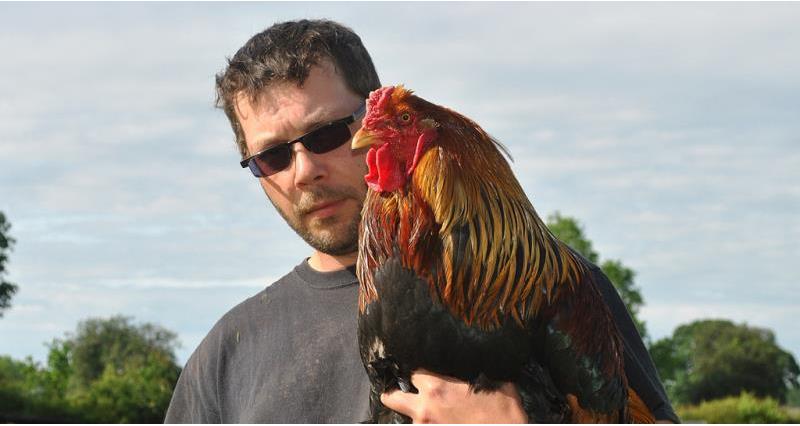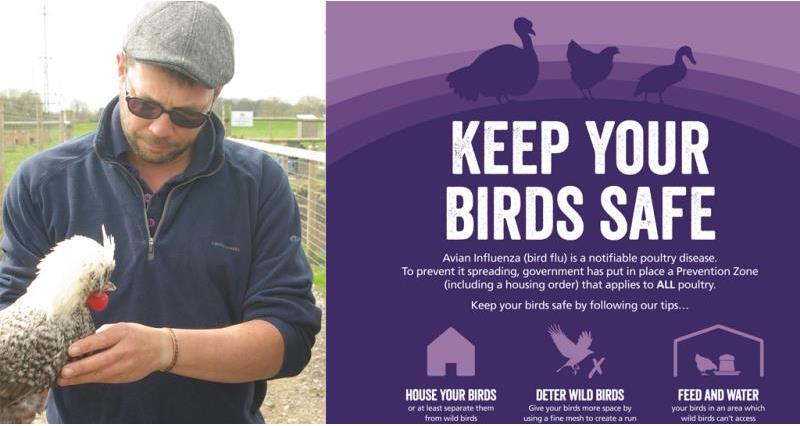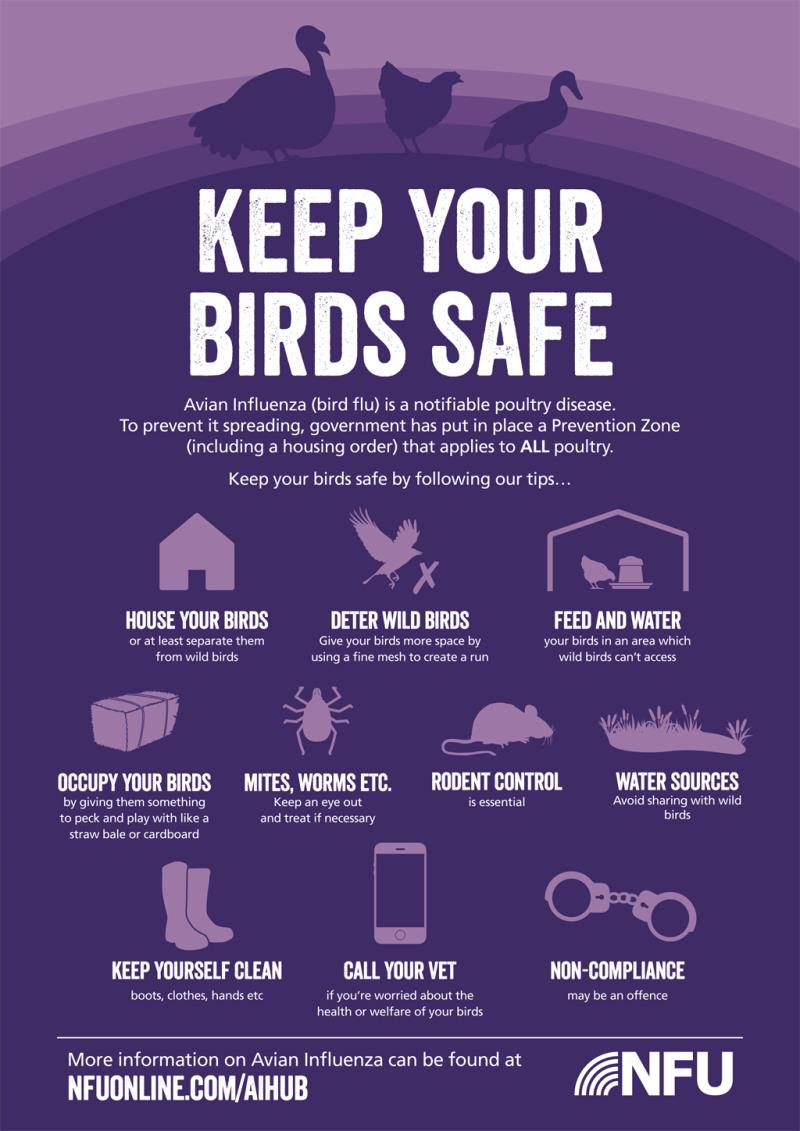He's written a blog aimed at smallholders and backyard poultry keepers, giving them tips on how to mitigate the risk of bird flu to their flocks.
The blog was posted on our Facebook page on 24 January. Since then it has reached over 110,000 people and has been viewed over 2,000 times on the Countryside website.
We thought it may be of interest to our Farmer and Grower members as many of you keep small flocks of poultry:

BIRD FLU AND THE BACKYARD POULTRY KEEPER
The morning of 7 December 2016 was being much like any other at that time of year. The weather had turned slightly mild and damp after a nice spell of icy cold weather. I remember thinking we could have done with another week of the cold weather just to ‘clean the ground’.
The poultry really do seem to benefit from seasonal shifts like that as opposed to the mild merge of muddy autumn into murky winter. Aside from that, they always look resplendent free ranging on a frosty, bright day.
Routine had the radio playing the Today programme on Radio 4 and it’s not every day that poultry makes it on to the news. No surprise then that my ears instinctively pricked up as the Chief Vet came on air and informed the reporters that due to outbreaks of a highly pathogenic strain of avian influenza sweeping across Europe, Defra have invoked a precautionary “prevention zone”.
ANDY'S TOP TIPS:
- Keep the flock indoors
- Keep the flock runs covered
- Keep moveable coops in the same place
- Keep your access to the housing and run area to a minimum
- Keep your equipment clean
- Keep feed and water out of the reach of wild birds
- Keep your birds contained
- Keep a close eye on your poultry
This order required all poultry and captive birds to be kept indoors for 30 days and heightened biosecurity requirements in order to reduce the risk posed to domestic birds from infected wild birds. Initially this only impacted England, however, within a day, Wales and Scotland quickly followed suit and the zone became GB-wide.
It had been on the cards. As the risk rose in Europe and outbreaks started popping up across the Continent, the impact of the widespread outbreak ten years ago still resonates. But for me it is not so much from an industry perspective, but from that of the backyarder and smallholder.
I haven’t done the maths but I suspect that a large proportion of poultry in the UK is owned by very few poultry keepers and, as such, a large element of the risk can be managed with a plan that works for a small minority of keepers – the commercial flock.
The reverse though is, that there are a lot of poultry keepers with low numbers of birds, and these are dispersed, relatively unregulated and unmonitored. We are also predominantly free rangers who view a chicken coop as a place where the birds roost and lay their eggs, as opposed to a building where the flock can be contained for 30 days, and there lies the crux.
Commercial keepers of thousands of birds have the capacity to contain their flocks within the sheds. It is a sensible and feasible approach – but what of the small-scale keeper?
Defra have stated the “The Prevention Zones requires all poultry and captive birds, including backyard flocks and other captive birds, to be housed or, where it is not practicable to do so, requires steps to be taken to keep them separate from wild birds. If you keep your birds near your home, consider housing them in alternative accommodation, such as a garden building, a garage or redundant building that could be adapted to house your birds temporarily.”
This is sound advice for those who have such buildings and Defra went on to say: “Remember to check for, and remove, hazardous and toxic substances such as rat bait, and make sure the birds have access to water and somewhere to perch. You must also practice good biosecurity - for example disinfecting footwear and equipment and washing clothing after contact with birds.”
Looking at this advice from a pragmatic perspective ‘indoors’ means protection from contact with wild birds and wild bird faeces so a covered run would serve well. Read Andy’s tips below.
At the beginning of January, despite the prevention measures being taken, avian flu had been found in commercial, backyard and wild birds across Great Britain. Most probably limited because of the Prevention Zone in place. The risk is still present and, as such, the Prevention Zone, and a ban on poultry gatherings is in place until at least 28 February.
I accept that it is tough for us small-scale keepers and I can empathize with the issues and arguments that accompany such an order but none of us can second guess the consequences if all of us of had done nothing. Where would we be now in terms of the existence of our backyard flocks? It is not something I could second guess, however it has proved a valuable experience and one I will be sure to plan for in future.
Tips from Andy on how to mitigate the risk of your flock coming into contact with wild birds or their faeces:
Keep the flock indoors – if this is possible then it is the easiest option but observe the welfare needs of the birds closely by increasing your cleaning regime, providing additional items of interest for your flock, and observing a tight biosecurity plan to reduce the risk of infection being carried into the housing. It should go without saying but any proposed building must also take into account the importance of adequate ventilation.
Keep the flock runs covered – permanent indoor housing might not be possible, in which case a cover over the run is needed. Small gauge mesh will only stop birds from entering the run and whilst better than nothing at all, a solid cover is far superior at reducing the risk because faeces can’t fall through the mesh (a tarpaulin can work well if tied down, although it needs to be tilted so rain can run off). Consider erecting a solid lean-to on the side of existing houses, this could be a fence panelling for example, or adapting a fruit cage using tarpaulin. Creating temporary outdoor pens using straw bales and a tarpaulin roof with small gaps for light and ventilation is another option. Be aware though if bad weather is likely to be a problem, it may be necessary to erect a windbreak around your structure.
Keep moveable coops in the same place – if your birds are housed in moveable arks or tractor units then don’t be tempted to move the house to fresh ground. This will simply increase the possibility of your flock coming into contact with wild bird faeces.
Keep your access to the housing and run area to a minimum – by doing this you will reduce the risk of you contaminating the area with wild bird faeces you may have come into contact with elsewhere on your property.
Keep your equipment clean - use disinfectant, such as Virkon, to keep equipment and footwear clean, and ensure the clothing you use when working with your poultry is washed after contact with birds.
Keep feed and water out of the reach of wild birds – make sure that drinkers are under cover and ideally put feeders in the coop. Avoid placing water in the house unless you are using nipple drinkers; regularly drinkers will get knocked over in any skirmishes in the coop.
Keep your birds contained – avoid unnecessary handling and movement of your birds on or off site, and where practical avoid visiting other poultry keeping establishments to reduce any possibility of cross-contamination.
Keep a close eye on your poultry – if you have any signs of illness then seek advice from a vet.
DOWNLOAD OUR AI POSTER BELOW:

